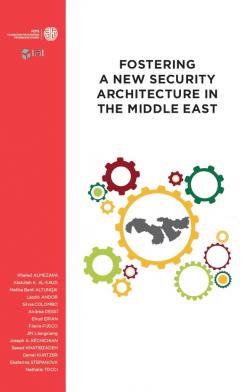Fostering a New Security Architecture in the Middle East
Il Medio Oriente sta sperimentando crescenti tensioni causate da agende geopolitiche in competizione e ingerenze reciproche negli affari interni degli stati. Questo volume – il risultato di un progetto congiunto FEPS-IAI – esamina vari mezzi per favorire in Medio Oriente la de-escalation, il dialogo e il rafforzamento della fiducia. Lo fa mappando i punti di vista, gli interessi e la percezione delle minacce dei principali attori regionali e internazionali nella regione. I casi studio dei singoli paesi, scritti da studiosi di Stati Uniti, Russia, Cina, Turchia, Israele, Arabia Saudita, Emirati Arabi Uniti, Iran ed Europa, sono accompagnati da un capitolo finale che analizza i risultati di un’indagine condotta tra gli esperti sulle modalità con cui gli attori regionali e internazionali possono sostenere gli sforzi per allentare le tensioni e aiutare la regione nello sviluppo di nuovi meccanismi locali per il dialogo e la cooperazione regionale.
Volume prodotto nell'ambito del progetto FEPS-IAI “Verso una nuova architettura di sicurezza in Medio Oriente”.
Foreword / László Andor and Nathalie Tocci, p. 7-9
1. The Middle East’s Evolving Security Landscape: Prospects for Regional Cooperation and US Engagement / Daniel Kurtzer, p. 11-36
1. US interests and policy
2. Security mechanisms in the Gulf
3. Security cooperation in the MENA region: Historical context (1945–1980)
4. GCC security cooperation (1981–present)
5. US, Russian and Iranian security cooperation proposals, 2017–2019
5.1 US Middle East Strategic Alliance (2017–present)
5.2 Russia’s Collective Security Concept for the Persian Gulf area
5.3 Iran’s Hormuz Peace Endeavour
6. Conclusion: Is there a way forward?
2. Russia’s Foreign and Security Policy in the Middle East: Entering the 2020s / Ekaterina Stepanova, p. 37-65
1. Russia’s balancing act in Syria
2. Libya: Does the Astana model apply?
3. Israel–Palestine: The peace process is dead, what role for Russia?
4. In lieu of conclusion: Russia’s Gulf security initiatives and the 2020 US–Iran crisis
3. China and Middle East Security Issues: Challenges, Perceptions and Positions / Jin Liangxiang, p. 67-89
1. The Middle East’s worsening security environment
1.1 Tensions caused by external actors
1.2 Instability due to economic factors
1.3 Tensions due to regional competition
2. Challenges to China
3. China’s role in regional security
4. Framework proposals for Gulf security: A Chinese view
5. Conclusion
4. The New Turn in Turkey’s Foreign Policy in the Middle East: Regional and Domestic Insecurities / Meliha Benli Altunısik, p. 91-113
1. Turkey’s perceptions of its evolving neighbourhood
1.1 Increasing threat perceptions and securitisation
1.2 Zero-sum regional competition
1.3 Increasing use of military power
1.4 Turkey’s newfound unilateralism: The search for autonomy and balancing efforts with major powers
2. Turkey’s new foreign policy doctrine
3. The Iran-Saudi rivalry and Gulf security: A view from Turkey
4. Conclusion
5. Structural Shifts and Regional Security: A View from Israel / Ehud Eiran, p. 115-138
1. Introduction: Israel’s traditional security maxims
2. Israel in a changing regional reality: immediate threats and responses
2.1 Traditional threats are gone
2.2 Current threats and responses: Iran, Hezbollah and the Palestinians
3. Israel and major structural regional security issues
3.1 American retrenchment
3.2 Enter Russia
3.3 The Sunni–Shia competition
3.4 Energy: Israel and the Hellenic alliance
4. Conclusion
6. The Evolving Security Landscape Around the Arabian Peninsula: A Saudi Perspective / Abdullah K. Al-Saud and Joseph A. Kéchichian, p. 139-166
1. Saudi relations with leading global powers
2. Adjusting to a new regional landscape
3. Regional security: Increased burdens for increased threats
4. Gulf security: Russian, US and Iranian proposals
5. Conclusion
7. HOPE for a New Regional Security Architecture: Toward a Hormuz Community / Saeed Khatibzadeh, p. 167-199
1. Understanding the challenges: Iran’s perception of the root cause of regional insecurity
2. Iran’s foreign policy: From idea to practice
2.1 Iran’s foreign policy under President Rouhani: From JCPOA to HOPE
3. Iran and major powers relations in the region: The US and Russia
3.1 Trump and Iran: From maximum pressure to maximum failure
3.2 Russia: A rising power in the Middle East
4. Iran’s neighbourhood policy: HOPE for a strong region
5. Conclusion
8. The UAE’s Security Perceptions in the Middle East: Regional Challenges, Alliances and the Diversification of Partners / Khalid Almezaini, p. 201-221
1. The security threats to the UAE: Real but not existential
2. The JCPOA and implications for regional security: A view from the Emirates
3. The UAE in the post-JCPOA context: Strategic hedging
4. Conclusion
9. Collective Security and Multilateral Engagement in the Middle East: What Role for the EU? / Silvia Colombo and Andrea Dessì, p. 223-247
1. Regional challenges: Socio-economic turmoil and geopolitical ruptures
2. EU cohesion and coherence: The challenge of (re)building consensus on interests and instruments
3. Stepping back from the brink: EU pathways for dialogue, de-escalation and confidence building in the Middle East
4. Conclusion
10. Countering Zero-Sum Relations in the Middle East: Insights from the Expert Survey / Flavia Fusco, p. 249-299
1. Framing instability: A multidimensional concept entangled in a zero-sum logic
2. Collective security in the Middle East: Can the past inform the present?
3. Future priorities: De-escalation, confidence-building measures and reconciliation
4. Conclusion: The way(s) forward
Abbreviations and acronyms, p. 301-302
Contributors, p. 303-310
Tema
Tag
Contenuti collegati
-
Ricerca20/02/2020
Verso una nuova architettura di sicurezza in Medio Oriente
leggi tutto




